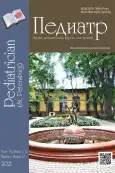Features of the lesion of the vascular bed in purulent meningitis in children
- Authors: Skripchenko N.V.1,2, Egorova E.S.1, Vilnits A.A.1,2, Gorelik E.Y.1
-
Affiliations:
- Pediatric Research and Clinical Center for Infectious Diseases
- St. Petersburg State Pediatric Medical University
- Issue: Vol 12, No 5 (2021)
- Pages: 27-35
- Section: Original studies
- URL: https://journals.rcsi.science/pediatr/article/view/104987
- DOI: https://doi.org/10.17816/PED12527-35
- ID: 104987
Cite item
Abstract
Background. Purulent meningitis occupies one of the important places in the structure of neuroinfectious diseases in children and is the top ten places among the causes of death. The relevance of their study is due to the severity of the course, high rates of disability and deaths (8–39%). Damage to the vascular bed during neuroinfections, including purulent meningitis, is a mandatory component due to the predominantly hematogenous pathway of pathogens. The penetration of microorganisms through the blood-brain barrier into the cranial cavity and their hematogenous intrathecal circulation cause damage to the cerebral veins and arteries, leading to the development of vasculopathies and vasculitis.
Aim: To determine the features of vascular disorders in purulent meningitis in children.
Materials and methods. 100 children with purulent meningitis were examined, aged from 1 to 17 years 11 months, for the period since 2007 to 2020. All patients underwent neurological monitoring, etiological verification of diagnoses, determination of markers of endothelial dysfunction in the blood (D-dimer and desquamated endothelial cells), as well as MRI of the brain and MRI angiography.
Results. A complex lesion of the vascular system in purulent meningitis in children was proved, associated with both structural and functional properties of the vascular wall, as well as damage to the vasomotor function of the endothelium.
Conclusions. With purulent meningitis, there is damage to the vascular bed in the form of systemic vasculitis, including cerebral vessels, as evidenced by the presence of both markers of endothelial damage (desquamated endothelial cells and D-dimer) and changes in MRI and MRI angiography.
Full Text
##article.viewOnOriginalSite##About the authors
Natalya V. Skripchenko
Pediatric Research and Clinical Center for Infectious Diseases; St. Petersburg State Pediatric Medical University
Author for correspondence.
Email: snv@niidi.ru
MD, PhD, Dr. Med. Sci, Deputy Director, Direction
Russian Federation, Saint Petersburg; Saint PetersburgEkaterina S. Egorova
Pediatric Research and Clinical Center for Infectious Diseases
Email: kate_inf@mail.ru
MD, PhD, Researcher, Department of Intensive Therapy and Urgent Cases
Russian Federation, Saint PetersburgAlla A. Vilnits
Pediatric Research and Clinical Center for Infectious Diseases; St. Petersburg State Pediatric Medical University
Email: vilnitz@mail.ru
MD, PhD, Dr. Med. Sci, Senior researcher, Department of Intensive Therapy and Urgent Cases
Russian Federation, Saint Petersburg; Saint PetersburgEvgeniy Yu. Gorelik
Pediatric Research and Clinical Center for Infectious Diseases
Email: e.gorelik@mail.ru
MD, PhD, Senior researcher, Department of Neuroinfections and Organic Pathology of the Nervous System
Russian Federation, Saint PetersburgReferences
- Vil’nits AA. Gnoinye meningity u detei: kliniko-patogeneticheskie, diagnosticheskie, prognosticheskie i terapevticheskie aspekty intrakranial’nykh oslozhnenii [dissertation]. Saint Petersburg; 2019. (In Russ.)
- Martynov VA, Zhdanovich LG, Karaseva EA, et al. Complications of bacterial meningitis. Infectious diseases: news, views, education. 2018;7(1):54–59. (In Russ.)
- Nagibina MV. Bakterial’nye gnoinye meningity: aktual’nye problemy patogeneza, diagnostiki i lecheniya [dissertation abstract]. Moscow; 2017. 46 p. (In Russ.)
- Petrishchev NN, Vlasov TD. Fiziologiya i patofiziologiya ehndoteliya. Saint Petersburg: SPbGMU; 2003. 438 p. (In Russ.)
- Selezneva SV. Tserebral’nye vaskulopatii (vaskulity): osobennosti kliniki, diagnostika, printsipy lecheniya. Zdorov’e Ukrainy. 2017;(3):42–43. (In Russ.)
- Skripchenko NV, Lobzin YuV, Vil’nits AA. Gnoinye meningity u detei: rukovodstvo dlya vrachei. 2-e izd., pererab. Saint Petersburg: SINEhL; 2017. (In Russ.)
- Skripchenko NV, Shirokova AS. Neuron-specific enolase and s100 protein as biomarkers of brain damage. Review and clinical application. Neirokhirurgiya i nevrologiya detskogo vozrasta. 2016;(4):16–25. (In Russ.)
- Skripchenko NV, Lobzin YuV, Voytenkov VB, et al. Innovations in the management of children’s neuroinfections. Children Infections. 2017;16(3):5–9. (In Russ.)
- Skripchenko NV, Trofimova TN, Ivanova GP, et al. Sovershenstvovanie lecheniya neiroinfektsii, protekayushchikh s sindromom vaskulita u detei. Vestnik ural’skoi meditsinskoi akademicheskoi nauki. 2010;(21): 290–293. (In Russ.)
- Soldatkin PK. Bakterial’nye meningity i meningoehntsefality: uchebnoe posobie. Blagoveshchensk: Amurskaya gosudarstvennaya meditsinskaya akademiya; 2016. 85 p. (In Russ.)
- Alamarat Z, Hasbun R. Management of Acute Bacterial Meningitis in Children. Infect and Drug Resist. 2020;13:4077–4089. doi: 10.2147/IDR.S240162
- Allama A, Ammarb H, Radwanc A. Serum homocysteine level and eye involvement in Egyptian patients with Behçet’s disease. The Egyptian Rheumatologist. 2014;36(1):29–34. doi: 10.1016/j.ejr.2013.09.002
- Engelen-Lee JY, Brouwer MC, Aronica E, van de Beek D. Delayed cerebral thrombosis complicating pneumococcal meningitis: An autopsy study. Ann Intensive Care. 2018;8(1):20. doi: 10.1186/s13613-018-0368-8
- Jillella DV, Wisco DR. Infectious causes of stroke. Curr Opin Infect Dis. 2019;32(3):285–292. doi: 10.1097/QCO.0000000000000547
- Mook-Kanamori BB, Geldhoff M, van der Poll T, van de Beek D. Pathogenesis and pathophysiology of pneumococcal meningitis. Clin Microbiol Rev. 2011;24(3): 557–591. doi: 10.1128/CMR.00008-11
- Poil AR, Shaukat A, Case KD. Pneumococcal Meningitis Complicated by Cerebral Vasculitis, Abscess, Hydrocephalus, and Hearing. Loss Rep Infect Dis. 2018;2018:8528023. doi: 10.1155/2018/8528023
- Ramineni KK, Bandaru O, Jakkani RK. Early cerebral vasculitic infarcts in acute pneumococcal meningitis. Curr J Neurol. 2020;19(1):45–46. doi: 10.18502/ijnl.v19i1.3293
- Rohlwink UK, Figaji AA. Biomarkers of Brain Injury in Cerebral Infections. Clin Chem. 2014;60(6):823–834. doi: 10.1373/clinchem.2013.212472
- Siegel JL. Acute bacterial meningitis and stroke. Neurol Neurochir Pol. 2019;53(4):242–250. doi: 10.5603/PJNNS.a2019.0032
- Smitka M, Bruck N, Engellandt K, et al. Clinical perspective on Primary Angiitis of the Central Nervous System in Childhood (cPACNS). Front Pediatr. 2020;8:281. doi: 10.3389/fped.2020.00281
- Yau B, Hunt NH, Mitchell AJ, Too LK. Blood–Brain Barrier Pathology and CNS Outcomes in Streptococcus pneumoniae Meningitis. Int J Mol Sci. 2018;19(11):3555. doi: 10.3390/ijms19113555
Supplementary files









